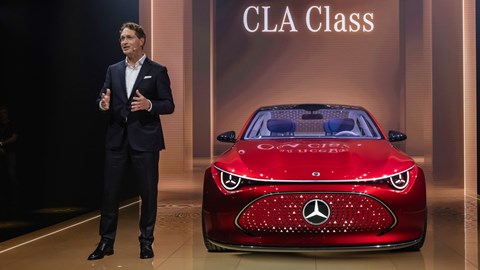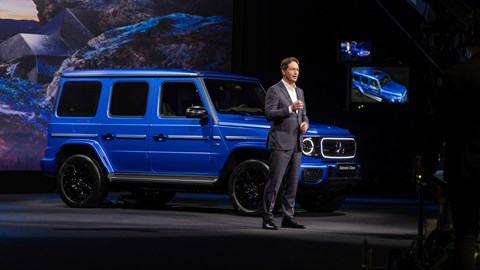► Dual strategy prompted by slow demand for EVs
► High hopes for innovative new CLA due next year
► Future electric and ICE models share the same names
Maybe this time we’ll listen. Mercedes boss Ola Källenius insists that when in 2020 he championed the move to full electric, there was a clause about ‘where market conditions allow’. But everyone just heard the bit about moving to full electric, and that’s not really happening very quickly.
He still says: ‘We’re moving towards a zero-emission future. So the destination has not changed. It’s zero-emission for the industry; it’s certainly zero-emission for Mercedes-Benz.’ But this time around there’s a fresh emphasis on continuing to offer a choice of combustion engines – not just leftover stock, but updated and improved combustion engines, all with some degree of electrification.
‘One decision we already made, back in 2020, that the combustion portfolio, all electrified, we’d have a complete overhaul of those ready by 2026.’ That’s in time to meet the next wave of emissions regulations in Europe, China and the US. ‘The combustion portfolio, from our brand new high-tech hybridised four-cylinder that we’re developing for the MMA platform, all the way up to the V8 that AMG customers and others love to death, that whole portfolio is available to us.’
Initial expectations that by now something like 20 or 25 per cent of new car sales in Europe would be electric have not been met – the reality is, on average, closer to 10 per cent.

‘If you are an established manufacturer, what is your reaction to that? Slam on the brakes, wait to see if the market will come again? Or do you press on? We have decided for the latter – press on,’ said Källenius, speaking to journalists at the Mercedes proving ground at Immendingen, Germany.
‘When I made the statement in 2020 – Mercedes-Benz will be in the position to serve markets with the complete electric portfolio, where market conditions allow – some people in your trade decided to not focus too much on the half-sentence after the comma. But I said it for a reason, because none of us have a crystal ball. I’m the first to admit I thought the whole market would be further at this stage, that we would be further.
‘So we are pressing on. We are now preparing for the biggest product offensive, number of launches of new vehicles, in the history of our company, kicking it off with the first one on the MMA architecture, the CLA.
‘I was driving it around the test track today, a fantastic car by the way. I’m ever so slightly biased, but it’s unbelievable. It’s a new car ushering in a new era, and ’25-’26-’27-’28’s just going to be one vehicle after the other. The intensity of launches in that period is unprecedented for our company.’
The future of Mercedes-Benz cars
The plan is to continue to offer cars in three broad categories: the top end (S-Class, AMGs, Maybachs, G-Class), the core (E-Class, C-Class etc) and a slimmed-down entry-level family based on the new CLA and GLA.
Expect future models to have different underpinnings for petrol and electric, but they’re likely to have the same name – so the next EQS would become an electric S-Class, but would be different under the skin. The pattern has already been established by the latest G-Class, where the electric and combustion versions all have G prefixes – so instead of EQ for the electric one it’s G580 with EQ Technology – and all look near identical.

Källenius also confirmed that an all-electric AMG is on its way – possibly previewed next year, definitely revealed in the metal in 2026. ‘We are working on a from-the-ground-up, white-sheet-of-paper, fully dedicated, electric performance platform. It will have mind-boggling performance. I have driven some of the early prototypes and I’m electrified.’
The need for ‘systemic change’ to enable mass EV adoption, not tariffs
Wider take-up of EVs would need a holistic approach, he said; however good the cars are, people won’t buy them if they’re too expensive or too difficult to live with. ‘It’s about systemic change: charging infrastructure, the cost of electricity, taxation and incentivisation. To just rest on product alone would be too narrow in your thinking.’
He cautioned against heavy-handed measures by European and US politicians wanting to stem the tide of Chinese EVs with tariffs.
‘I think it is not the right strategy to turn to protectionism,’ he said. ‘It’s fundamentally against your own business model. That does not mean that I don’t think we should do what is necessary to create a level playing field. Let’s have a discussion about a level playing field. But to resort to the very crude method of just putting up a wall, a tariff, that maybe then kicks off a reaction on the other side, you then in the worst case have an escalating trade conflict. That would be to lose-lose. Certainly for a player dependent on exports, it’s not the right strategy. Try to find a negotiated solution. Don’t shut off markets. It’s going to stifle growth and make us weaker.’
In a time of transformation, it was natural that start-ups should see an opportunity.
‘In China at the moment you have more than 100 makers in the EV segment. Will there be some level of consolidation over the next five to 10 years? I absolutely believe so. We’re seeing a natural development of the market, a competitively intense period. Now is the time to really double down on your brand promise, not sit back. Invest higher than you probably have ever done, but also double down on efficiency to make sure you can afford that investment, make sure you produce positive cashflows in this tough environment, so you can be your own venture capitalist. Make sure you have a sound balance sheet so you have a little bit of a war chest. We’re doing our best to navigate through that.’